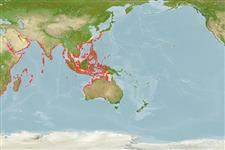Common names from other countries
>
Clupeiformes (Herrings) >
Engraulidae (Anchovies) > Engraulinae
Etymology: Encrasicholina: Greek, egkrasicholos, -os, -on = mixed with spleen.
More on author: Fowler.
Environment: milieu / climate zone / depth range / distribution range
นิเวศวิทยา
เกี่ยวกับทะเล,น้ำเค็ม เกี่ยวกับหินโสโครก; สัตว์น้ำที่อาศัยและอพยพภายในทะเลเท่านั้น (Ref. 51243); ระดับความลึก 5 - 35 m (Ref. 86942). Tropical; 42°N - 35°S, 30°E - 140°E (Ref. 189)
Indo-Pacific: Red Sea and Persian Gulf south to perhaps Durban in South Africa, Pakistan, India, Sri Lanka, and probably Burma. Also from southern Japan to China, Philippines, Thailand, Indonesia south to Brisbane, Australia, Japan eastward to Hawaii, the Solomon Islands, Fiji, Samoa and Tahiti.
Length at first maturity / ขนาด / น้ำหนัก / Age
Maturity: Lm ?, range 7 - ? cm
Max length : 13.0 cm TL เพศผู้/กระเทย; (Ref. 189)
เงี่ยงครีบหลัง (รวม) : 0; ก้านครีบอ่อนที่หาง (รวม) : 12 - 15; เงี่ยงครีบก้น: 0; ก้านครีบอ่อนที่ก้น: 14 - 17. Belly rounded with 3 to 6 sharp needle-like pre-pelvic scutes. Maxilla tip blunt, scarcely projecting beyond second supra-maxilla, not reaching to front border of pre-operculum. Isthmus short, preceded by small fleshy plate on urohyal between branchial membranes. Anal fin short, its origin behind base of last dorsal fin ray.
Epipelagic (Ref. 58302). A schooling species found inshore and in oceanic waters, hundreds of miles from land. Sometimes entering large atoll lagoons or deep, clear bays. Ranks among the most important food (bait) for tuna and other large pelagic fishes (Ref. 1602). Processed into nuoc-mam, a kind of fish pickle, in Indo-China (Ref. 4929).
Spawn in school (Ref. 205).
Whitehead, P.J.P., G.J. Nelson and T. Wongratana, 1988. FAO Species Catalogue. Vol. 7. Clupeoid fishes of the world (Suborder Clupeoidei). An annotated and illustrated catalogue of the herrings, sardines, pilchards, sprats, shads, anchovies and wolf-herrings. FAO Fish. Synop. 125(7/2):305-579. Rome: FAO. (Ref. 189)
IUCN Red List Status (Ref. 130435)
CITES (Ref. 128078)
Not Evaluated
Threat to humans
Harmless
Human uses
การประมง: มีการค้าเพียงเล็กน้อย; เหยื่อ: usually
เครื่องมือ
Special reports
Download XML
แหล่งที่มาจากอินเตอร์เน็ต
Estimates based on models
Preferred temperature (Ref.
115969): 24.7 - 29.2, mean 28.3 (based on 928 cells).
Phylogenetic diversity index (Ref.
82804): PD
50 = 0.5039 [Uniqueness, from 0.5 = low to 2.0 = high].
Bayesian length-weight: a=0.00479 (0.00307 - 0.00746), b=3.26 (3.13 - 3.39), in cm Total Length, based on LWR estimates for this species & (Sub)family-body (Ref.
93245).
ระดับชั้นอาหาร (Ref.
69278): 3.4 ±0.45 se; based on food items.
ความสามารถในการกลับคืนสู่ปกติ (Ref.
120179): ความสูง, เวลาต่ำสุดที่จะทำให้ประชากรเพิ่มขึ้นเป็น 2 เท่าใช้เวลาน้อยกว่า 15 เดือน (K=1.1-2.0).
Fishing Vulnerability (Ref.
59153): Low vulnerability (12 of 100).
